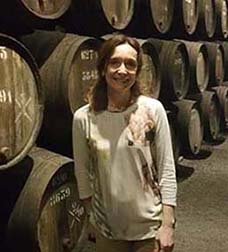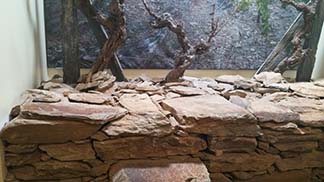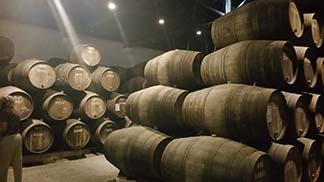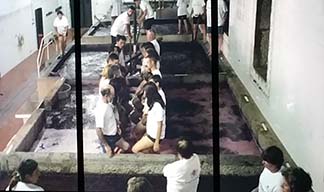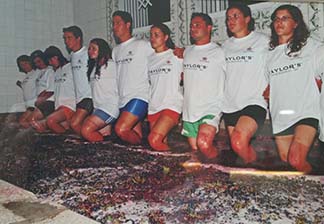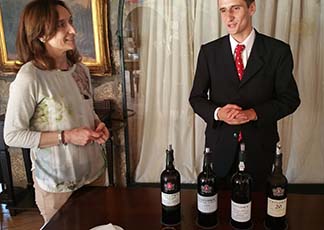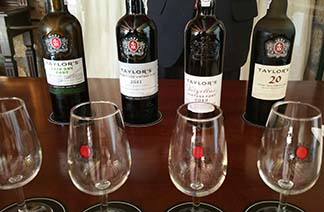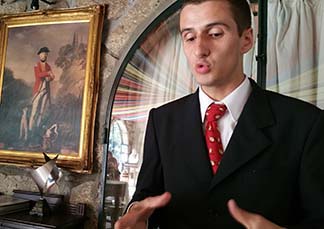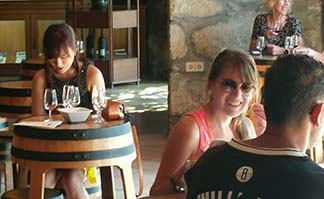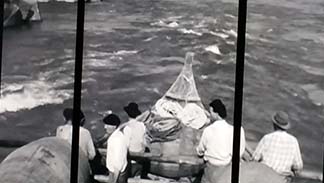The oldest demarcated wine region in the world in not in France. It is in Portugal, in the Douro region near Porto, famous for port wine, and a necessary stop on any traveler‘s tour of the country. Though the vineyards are an hour-and-a-half distant and more, the cellars are in Vila Nova de Gaia, just across the river from Porto. There, port wine companies have set up tours and tastings, and we spent a happy few hours there under the tutelage of Taylor Port‘s Claire Aukett.
In the U.S., the brand is called Taylor Fladgate, because when Taylor’s went to registered it, the name already existed.
Taylor’s has been making port since 1692. It‘s a British name, because the family that owns it is of British origin. Why Brits? Claire explained, “That goes back to the days in the 18th century, when the king in France increased taxes.
The British weren‘t going to buy more French wine. They were already dealing in wool with their old ally, Portugal. So, the English bought table wine from Portugal and shipped it back to England. But table wine didn‘t travel well. The boat rocked, the temperature changed. Somebody thought it might be a good idea to add some brandy to see if it would make the wine last longer.
When the wine got to England, the English loved the sweeter wine, so port wine — wine from Porto — was born. That was three centuries ago.
The grapes need to be grown in the Douro Valley because of its micro climate, the combination of soil and climate. It gets cold at night and hot in the daytime, to over 100 degrees. It is protected by a mountain range, and there is no pollution.
The terracing, which also dates to the 18th century, is done to prevent erosion and to permit workers to walk along the paths to tend the vines. This sustainable terrace model uses rock as “the earth” for the roots, which keeps the heat in and doesn‘t require irrigation.
The Douro Valley is Portugal‘s most important wine region, for table wine and port. The deepest part of the Douro, beyond the mountains, is a UNESCO World Heritage area.
The cellars are in Vila Nova de Gaia because conditions are colder and damper, better for aging wine. As we walked through the caves, Claire showed us giant casks. The largest – the largest cask in Europe — holds 100,000 liters, that will be decanted to more than 100,000 bottles of port. Other barrels hold 600 liters.
And she discussed the different kinds of port. There is red port, white port and tawney. The best reds are vintage ports, bottled in exceptional years. Red ports LBV (late bottled vintage) were developed by Taylor‘s as a less expensive option. White port, also invented by Taylor’s in 1934, is dryer than red. Tawney is sweeter.
In more detail: vintage red ports spend two years aging in a barrel and the rest of their lives in the bottle. Old ports when opened will oxidize quickly and need to be drunk in a few days. The red wine in the giant barrel is full-bodied and fruity. LBV red ports spend 4 to 6 years in a bottle, and last longer than vintages when opened. The whites spend 2 to 5 years in the vat, then are bottled.
Tawney, slightly sweeter, is aged in smaller barrels, has greater contact with air and wood, absorbs more flavors from the wood, is nuttier, and of an amber hue. Tawnies are 10, 20, 30, 40-year-old blends, so a 20 will have some wine less than 20 but also some 30. The goal is a house style. But there‘s also now a trend for single harvest Tawnies, from one particular year. There’s one from 1863.
Much of what Claire told us on our walk-through is on short videos set up through the caves and in an attached museum, part of a visitors’ center, including films about the harvest and the wine.
So we backed up to start from what happens at the quinta after the grapes are picked in the fall. Quinta means winery in Portuguese, and Taylor’s own three of them. For me, the most fascinating part of making port is the treading. Taylor’s really does start the process by having “stompers” – people who have been doing this for years – tread on the grapes. Claire explained, “They go back and forward, they do a dance. So the grapes don‘t release harsh tannins, it’s still the best way.” We saw film and photos of it.
Then fermentation turns sugar to alcohol, and pure grape spirit is added to fortify the wine and stop additional sugar turning to alcohol, which keeps the wine sweeter. The following spring, the wine is brought to the caves at Vila Nova de Gaia. What we and other visitors see there is a working cellar, with the clear aroma of port wine.
Finally, we saw the video of a Portuguese ritual, removing the cork by using hot tongs to break the neck of the bottle off, cleanly. No live demonstration!
Now to the tasting room!
Philip Brunner runs the Taylor’s tasting room. It‘s an expansive space with a bar and tables that opens onto a garden where people can bring their wines and hobnob with a colorful family of peacocks and a rooster.
Philip, of Swiss-English origin, tells us about the wines before pouring them. White port, for example, is “chip dry,” an alternative to sweet port. Taylor’s white is the only port wine made only with white grape varieties, good chilled as an aperitif. Philip said it was a popular cocktail with tonic water, “Porto tonic.” It‘s very popular in the UK, Spain and France, but not known that much worldwide.”
I found it full and rich, but not too sweet, not sugary. It is 20% alcohol, compared to 7.8 to 14% for table wines. It has only 30 grams of sugar per liter, compared to Tawney with over 200 grams. (About sugar, if you eat 2,000 calories a day, you should eat less than 200 calories (50 grams) of added sugar. The American Heart Association recommends women consume no more than 100 calories (24 grams) of added sugar a day; men, no more than 150 calories (36 grams).)
After the chip dry, Taylor’s invented the late bottled vintage, LBV, as something similar to vintage port. Philip explained that vintage “is produced only two or three times a decade. It‘s extremely expensive, you have to wait 20 years for aging and then drink it in two or three days.”
He said, “The late bottled vintage is a way of cheating that. It’s produced every year and left longer in the barrel, making it ready to drink early, bottled and ready to drink in 4 to 6 years. We advise you to drink straightaway. It won’t improve in the bottle. As it has suffered oxidation during aging, you can keep it open for two months.”
I found the LBV full bodied, fruity, a little bit tannic. Philip explained, “It hasn’t had time to get the tannic round. After 20 years, it will be a softer port.”
Then we went to the vintage port. I think the tasting order must have been dry to sweet. Two ports are called vintage, single quintas and classic vintages, the latter very expensive. Vintages are made from a single harvesting year. Those bottled in 2014 are sold today.
I thought the second was rich and full and not too sweet. I said, “This is richer, more complex, not as tannic.” Vintage port is more intense. Philip said it spends little time in wood and will last two months.
The price difference between the vintage and LBV was 50 and 15 euros My companion said, “I can‘t tell the 35 euro difference.” Philip said, “You would in 30 years‘ time.” You would pay 50 euros now and let it sit for 30 or 40 years. He said, “People choose a year that has a meaning to them, the year they got married, when kids were born. They let it sit till an occasion.” Old port can last 100 years lying down. Philip is a young man with a long view of the years!
He explained that Tawnies are completely different. Blends and single harvests mature all their lives in wood, for at least ten years. The single harvest port wines age in small casks. He said, “We have a 1966 single harvest that has spent 49 years in small casks. It was a classic vintage. It would have characteristics of the wood it has aged in.”
The Tawney we tried was more nutty, perfect with gorgonzola cheese. Philip said, “That comes from the wood.” They are more acid than vintage ports. He added that reds go with blue cheese.
He offered a tip, “If you find Tawney with a bar top, a short cork, it should be drunk within two years. “Take off the wrapping and pull up the cork. It will not lie down. Then you have two months to drink it. A normal cork keeps longer.”
Who drinks port? The Brits, and then after that the French, who take it as an aperitif, and the Americans. Taylor’s ports are sold in the U.S. in large cities, NY, LA, San Francisco. They are harder to find in small cities.
IF YOU GO
Taylor’s in Vila Nova de Gaia.
Taylor-Fladgate & Yeatman, Rua do Choupelo 250, Vila Nova de Gaia.
The visitors center tour costs 12 euros, no reservation needed. After the tour, you taste a Chip Dry – Extra Dry White and a Late Bottled Vintage (LBV). You can buy more wines, most from 3 to 7 euros a glass and snacks such as cheese and ham to enjoy on the terrace.
Open daily 10 to 7:30, last entry at 6pm
Audio-guided tour lasts one hour, though if people choose to watch all the videos a visit can last for 2 hours, with another 30 minutes for the tasting.
Tel. 351 223 772 956 / 351 223 742 800
Fax. 351 223 742 899
Taylor’s Visitors Center.
Taylor Fladgate.
For private tours an*******@ta****.pt.
Photos by Lucy Komisar


